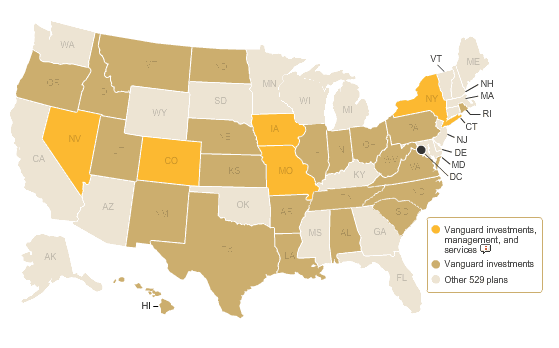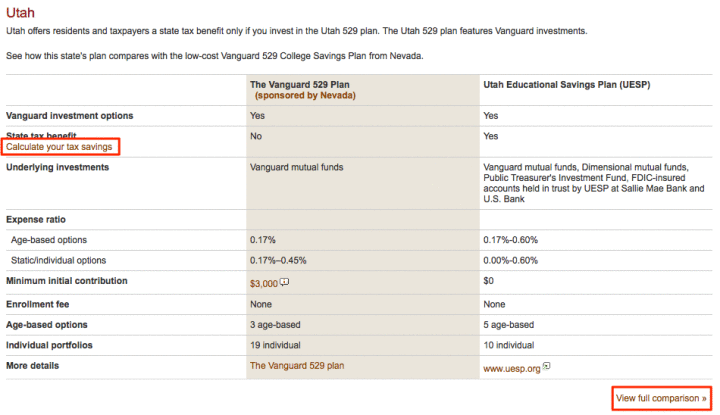The Vanguard 529 College Savings Plan (based in Nevada but open to all state residents) is one of the consistent Morningstar top-ranked 529 plans and one of my three personal finalists when choosing a plan for myself.
While poking around the site, I also came across this interactive map tool that helps you compare your in-state plan with the Vanguard/Nevada plan. Although created by Vanguard, it still offers a lot of useful information and I’m okay with then Vanguard plan being used as a benchmark.
Below is an example screenshot for Utah. Note that it will tell you if you have an in-state tax benefits, and also if that tax benefit is restricted to contributions to your in-state plan only. Where applicable, it also links to Vanguard’s 529 tax deduction calculator. Finally, if you click on “Full Comparison” you can dig even deeper.
As an example of why Vanguard is highly-regarded, I was recently notified that Vanguard once again lowered the expense ratios on many of their 529 investment options. This matches the same trend with their regular mutual funds and ETFs.
Effective May 3, 2016, the expense ratios for all Vanguard 529 Plan investment options went down, affirming Vanguard’s ongoing commitment to lowering costs for our clients. Now you’ll be saving even more. The cost of our age-based options decreased from 0.19% to 0.17%, which is 67% less than the industry average.* And the expense ratios of our individual portfolios dropped from a range of 0.19% to 0.49% to a range of 0.17% to 0.45%.
Here are some similar resources I’ve shared before: 50-state 529 tax benefit comparison (uses a common hypothetical family) and SavingForCollege tax benefit calculator.


 The Best Credit Card Bonus Offers – 2025
The Best Credit Card Bonus Offers – 2025 Big List of Free Stocks from Brokerage Apps
Big List of Free Stocks from Brokerage Apps Best Interest Rates on Cash - 2025
Best Interest Rates on Cash - 2025 Free Credit Scores x 3 + Free Credit Monitoring
Free Credit Scores x 3 + Free Credit Monitoring Best No Fee 0% APR Balance Transfer Offers
Best No Fee 0% APR Balance Transfer Offers Little-Known Cellular Data Plans That Can Save Big Money
Little-Known Cellular Data Plans That Can Save Big Money How To Haggle Your Cable or Direct TV Bill
How To Haggle Your Cable or Direct TV Bill Big List of Free Consumer Data Reports (Credit, Rent, Work)
Big List of Free Consumer Data Reports (Credit, Rent, Work)
Jonathan,
Thanks again for another worthwhile post. I use Vanguard’s Nevada Plan, the Utah Plan and the Ohio Plan. My home state, Florida, does not offer tax benefits.
Quick observation: It appears that if you use the Vanguard map and use their tools, the link to the state plan takes you back to the Vanguard site, rather than to the respective 529 plan? For example, I clicked on the http://www.myfloridaprepaid.com link and was directed back to Vanguard. Surely this most be a mistake?
Perhaps you could notify Vanguard of this problem with their site.
The CA 529 is rarely discussed, but for the index fund options in the CA 529 are cheaper than NV’s (Vanguard’s) 529
CA 529 ERs for intl stock index, US stock index, and US bond index are 0.14%, 0.10%, and 0.17%, respectively.
NV 529 ERs for intl stock index, US stock index, and US bond index are 0.35%, 0.19%, and 0.22%, respectively.
The passively managed age based portfolios in the CA 529 range from 0.18% to 0.12%.
The age based portfolios in the NV 529, which I believe are passively managed, all have an ER of 0.17%.
Once one has maxed out one’s state’s 529 tax benefit, one should take a hard look at CA’s 529.
Note that this vanguard page linked from the tool has incorrect information for the Virginia comparison regarding maximum annual state deduction: https://vanguard.wealthmsi.com/comp529main.php?vang1=97&planid1=55&planid2=.
So I might question the exact accuracy of the data presented here about other plans.
Agree with above post.
The vanguard tool says 400k a year is allowed into Colorado plans. Max is 30k for couple/20k individual.
Also I am confused as everywhere I’ve seen says it’s a dollar for dollar match which means if you owed $400 and contributed $400 you would owe zero.